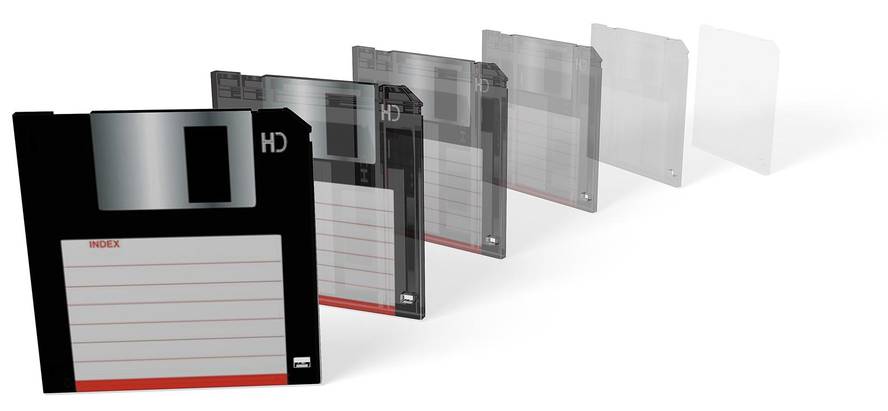Electronic amnesia
A few months ago, while ordering in my office a shelf with dust, I discovered an archaeological treasure: A box full of 3.5 inch floppy disks. An archaeologist would first define the date of discovery. So I looked at the labels. They were erased by hand and told me they were from the late 20th century, from 1989 to 1995.
I had great hope. Could any of these floppy disks find unexpected finds (similar to love letters that appeared in an old suitcase found in the camera tied with silk tape)? On the labels there was no romanticism, just put "Backup". To make things worse my laptop was in 2007 and had no disquetera.
Putting the first disc into an external disc reader -- a reader left by a friend -- a window appeared that was empty.
Pressing "Get Info" to learn more about the album, I saw that there was no free byte. The same happened with the other diskettes. What happened? Of course there was something on the floppies. But in 1998 my friend bought the floppy after Apple removed the floppy readers and did not read older floppy disks.
I began to realize something. My grandmother's photo album was always visible at a glance, even after the photos began to close. I can still read his handwritten letters, although the black ink has become light brown. However, my generation, proud of its relationship with modern technologies, needs machines to reach their memories, but these machines are short-lived and are rapidly disappearing.
My next step was to visit a friend. Nenad Jovanovic, based in Barcelona, brings together old Macintosh computers. He proposes to insert diskettes into a computer according to his age. He took a box from a shelf and used it very carefully, as if he had a Ming container. Who says he is not as valuable as he is? It is possible that one day we have to resort to such museums to recover our personal memories.
Inside kutxa is an LCII, one of the first color models of Macintosh at a reasonable price, marketed in 1992. A box full of cables has been tracked, the right power cord has been found and the computer has been launched.
I've put my first album into the drive, and there are all the memories I've long forgotten, among others, countless letters written to friends and family. All are Word files without image, each of which only occupies two or three kilobytes. I had to remember that in the early nineties we still used photographic films, sent the letters from the post office and saw instant messaging through video file computers on Star Trek.
But how can I save the newly found documents? Is the driver of a current printer compatible with the museum computer?
Well, no.
But Nenad has a better idea. He has tracked his boxes and pulled out an old modem. Soon after, the old grandfather LCII is connected to the Internet and gradually, one by one (he is breathing! ), my documentation is being emailed to my new laptop for storage.
On the laptop my old cards are opened correctly, but there are files that have an “unknown format”. The current version of the software used to create these files does not support the files created in 1995 with an earlier version. Only seventeen years have passed since then, but for computer programming we could say that those of then are obsolete prehistoric languages.
It is a very serious problem. On the one hand, in our society we have the obsession of recording our lives: emails, photos, videos and other files. But on the other hand, we have not saved devices capable of deciphering those memories. In this way, you run the risk of becoming as forgotten as the Mayan alphabet, as a floppy disk of the 80s, a DVD with jpg photographs of 2000 in a folder and a USB memory of 2012. Within twenty-five years will our computers continue to be able to read DVDs? Are not USB connectors so useful for external drives in danger of gradual extinction? How will our children and grandchildren assimilate the history of the family?
Is it possible to combine the advantages of modern electronic formats (speed, mobility, color, sound and music) with universal utility?
I have returned to my personal file. There is still a record that puts on the label "1989". It is a real dinosaur. Storage capacity of one full megabyte. At that time, it was a revolutionary innovation, a floppy disk that was as proud as I am now of a terabyte's external hard drive.
Nenad has put his disk into a Mac Plus that was released between 1986 and 1990. A window with a story folder appears. I opened the first one and fortunately the computer started scanning. But one day the misfortune. An error message with damaged data appears on the screen. Blank screen. I have almost heard the mockery of my story evaporating and have disappeared into the sky (or I have to say it in the cloud) in the big data cemetery. ). I know that after a decade or two magnetic data can begin to erase. That's why I threw the floppy away. But everything has not been lost. In a brief review of my story (not to say that it was not at all as good as I remembered it), some data have been passed to another storage service, that of my brain and its memory of low reliability. I've made a loaded coffee to improve RAM and got back to work right away...







